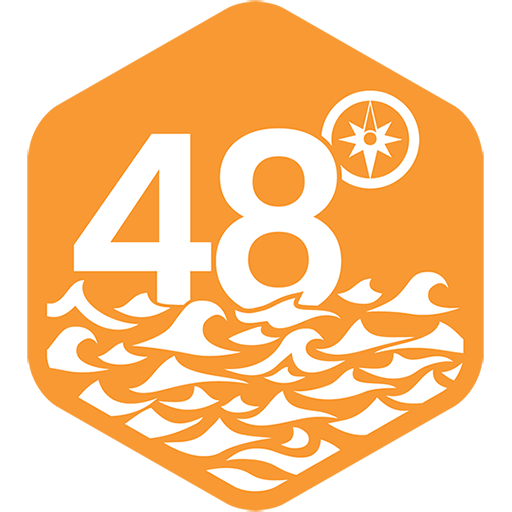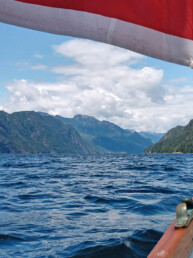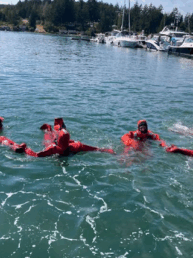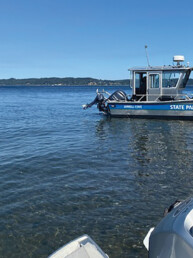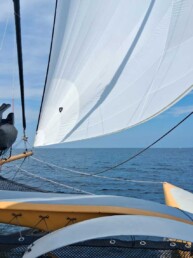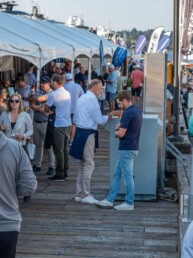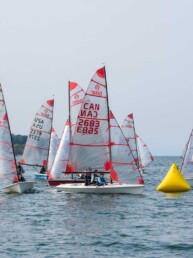A conversation with winning skipper Dalton Bergan about the first national level regatta in the region for this rapidly growing one-design.
The J/70 one-design activity in the Pacific Northwest continues its meteoric rise and, on June 13-15, the booming fleet celebrated its first National Championship regatta in the region—the Mixed-Plus Nationals—hosted by Corinthian Yacht Club of Seattle.
The 22.5-foot J/70 is beloved for many reasons, but one is that it can be well sailed by just about anyone. This is not a ‘hulking bros only’ kind of a boat, with its comparatively light line loads and the restriction that only two crew may hike with their legs out. It is designed to be enjoyed by sailors across a wide array of ages and physical capabilities. The Mixed-Plus category is all about leaning into that idea and encouraging participation from women, children, and families sailing together. Mixed-Plus entails that no crew (typically four or five sailors) shall include more than two males over 18 years old.
So it was that the fleet assembled for a fun three-day national level regatta out of Shilshole Bay Marina. Seventeen boats participated in the event, most of which were local boats with local crews, but a few traveled from the North Sound contingent, as well as the Hood River area, and California. The fleet included some of the region’s most accomplished sailors, and racing promised to be tight and competitive, but friendly—as is the custom in the “J/Pod.”
On the whole it was a fairly light air regatta. Friday had the best conditions, with a consistent 8-10 knots of breeze and four races scored, enough to do some wing-on-wing sailing with the spinnakers (just referred to as “wing” in J/70 circles). Everything else was sailed in 5-8 knots, with variable breeze allowing for only one race on Saturday, and two more on Sunday.
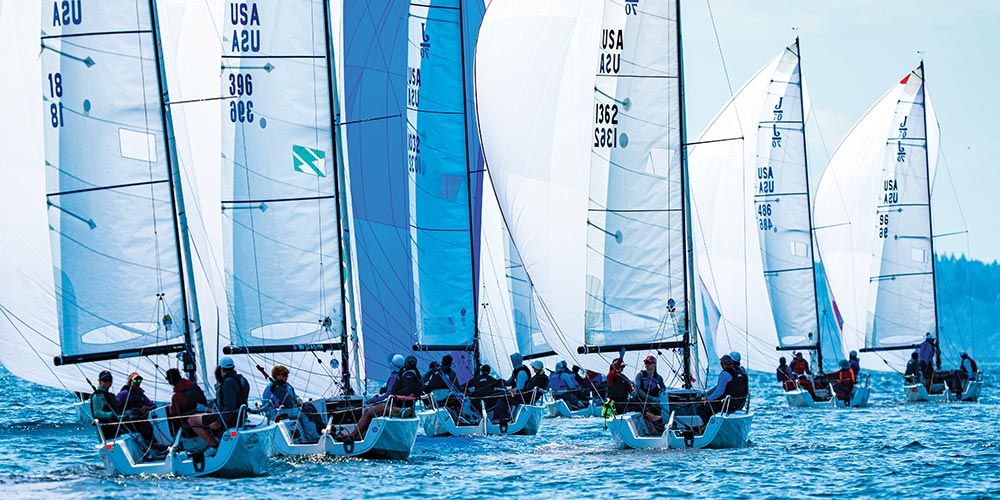
Fast forward to the end of the weekend, and Dalton and Lindsay Bergan’s Mossy stood atop the podium, with Boris Luchterhand’s Riff and Michael Goldfarb’s War Canoe one and two points behind, respectively.
Dalton and Lindsay are some of the best known and most decorated sailors around, and their trophy case includes wins at the 2022 Tasar World Championships, which they sailed together, and a win for Dalton sailing solo at the RS Aero Worlds in the same year. They only acquired Mossy in January so they’re still getting to know the boat, but it’s no surprise that they’re quickly near the top of the competitive J/70 fleet, especially with their experienced crew of Ben Glass and Regan Edwards.
It’s always interesting to talk with Dalton and learn what he is seeing and thinking about when it comes to boat racing, and 48° North had a chance to catch up with him shortly after he skippered Mossy to this Mixed-Plus National Championship victory.
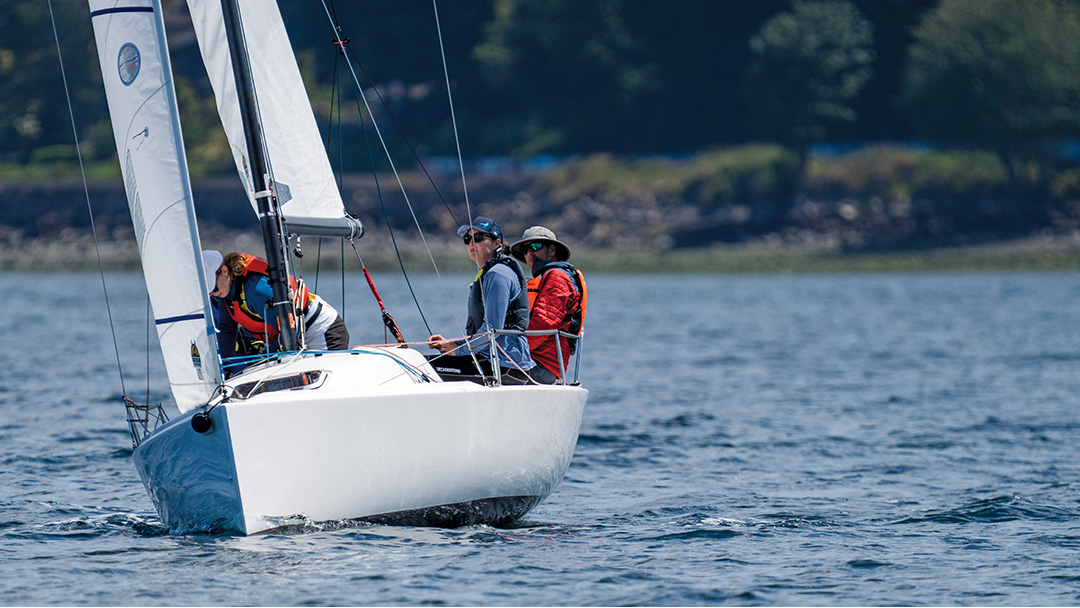
One of Dalton’s first observations was about the venue characteristics, and how they differed on Puget Sound from where the Seattle fleet is typically based at Leschi on Lake Washington. Adding to the intrigue of sailing on the lake are the big shifts and pressure differentials paired with shorter courses, which can mean more variation in the results. Dalton says, “It’s really competitive and fun, a lot of boats can win a race.” On the Sound for this regatta, the conditions provided more consistency on longer courses, which he described as creating, “more of a boat speed factor.”
In such tight one design racing, the speeds were very even, but on longer courses, a few boat lengths here or there are tough to recover. Dalton felt “Riff had a speed edge on us most of the time upwind,” especially when the wind got light; though he also noted, “War Canoe was probably the fastest upwind overall.” When the breeze came up a bit, he found the speeds between the top portion of the fleet to be very equal.
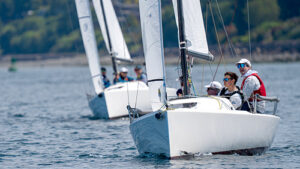
Boat speed is the outcome of a host of factors, and the Bergans displayed predictable savvy in their effort to solve that ever-changing puzzle. Even in their short time with the boat, they are customizing their set-up, starting with the rig settings in the tuning guide but quickly adapting those settings for their specific mast. Dalton also cut their shrouds down so that they could rake the mast more and still have enough adjustability with rig tension. He says of their boat prep, “It’s nothing huge, but it all stacks up.”
Ruminating on the things they’re learning about the boat while getting up to speed, Dalton described the dynamism with a narrow wind range between being under- and over-powered. “It’s interesting that the boats go from underpowered up to about 7-8 knots, and there’s this small 8-, 9-, possibly 10-knot window when you’re correctly-powered, and then at 10 knots you’re definitely overpowered. So you could be transitioning from
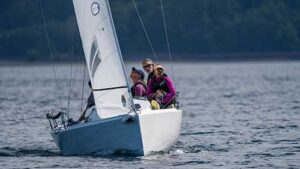
underpowered to overpowered in puffs and lulls on a beat.” He continued, “It’s a narrow boat without much righting moment, and you sail it really flat. You can’t pinch to get yourself a lane, pretty soon you’re just going to start sliding. If your target speed is 5.7, maybe you can get to 6 knots, but if you’re below 5.4 knots, you’re all of a sudden sliding sideways.”
Another challenge in the breeze band for this regatta is that you need to have the mainsail fairly stalled, meaning there’s a lot of feel and not much visual feedback. A top sailor in the fleet, Jen Glass, was trimming on War Canoe, and shared with Dalton that she was stalling all the main telltales except the very bottom one.
Dalton observed that Mossy had a slight speed advantage downwind some of the time, of which he said, “Ben’s a really good spinnaker trimmer. The pole on the boat is a little short from what I could tell, so you’ve really got to keep the kite pretty loose to keep the gap between the main and the spinnaker open.”
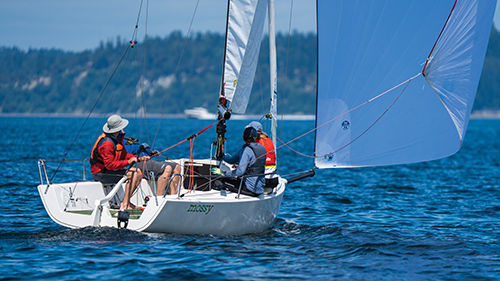
In lots of ways, Ben’s background on the J/70 was extremely valuable for their team. “Ben’s done a lot of J/70 sailing over the years,” Dalton said, “he was very instrumental in knowing how to set the boat up and do the maneuvers.” Notably, he helped illuminate some of the best practices for boat handling when getting on the wing. For example, depending on whether you’re jibing the kite or main to get onto the wing, you want to either roll the boat or keep it dead flat—and Ben’s knowledge fast-tracked dialing those moves in for the Mossy team.
As happens when fleets grow to a certain size, there’s not just one race taking place, but rather great little battles within different segments of the fleet. No one was relegated to DFL in every race, so there were always places to be exchanged and close crosses and roundings, from the front to the back of the fleet. Still, by the end of the first day, the top three had already started to distance themselves from the pack in terms of scoring, and that would remain true through the last race.
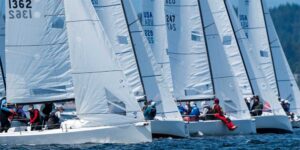
Dalton praised local J/70 coach, Ron Roserberg, for his great work with fleet growth, skill development, and the cohesive community dynamic. Dalton appreciated “the open debriefs” after racing and how much Ron focuses on the question, “How do we help everyone get better?” Even a racer as experienced as Dalton picked up some rich food for thought in the debriefs, like the suggestion to have more patience when building speed after maneuvers, or some ideas about VMG thresholds on and off the wing. ”If you’re going 6.5 knots or more downwind, you should probably be thinking about winging; and if you’re winging and going 5.5 knots or less, you should be going off the wing. Those are interesting numbers to consider.” Throughout the fleet, Dalton said, “Everyone is generally psyched to be there and work together.”
This will certainly not be the last major J/70 regatta to be held here in the Pacific Northwest, so it will be exciting to continue to track the fleet’s growth and activity in the coming years. For now, the class’s first National Championship held in the region is in the books, and it was a big success, a lot of fun, and a terrific learning experience for all involved.
Full results at www.cycseattle.org
Photos courtesy of Dennis Pearce Photography.
Joe Cline
Joe Cline has been the Managing Editor of 48° North since 2014. From his career to his volunteer leadership in the marine industry, from racing sailboats large and small to his discovery of Pacific Northwest cruising —Joe is as sail-smitten as they come. Joe and his wife, Kaylin, have welcomed a couple of beautiful kiddos in the last few years, and he is enjoying fatherhood while still finding time to make a little music and even occasionally go sailing.
